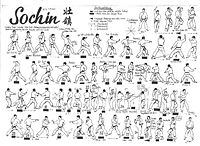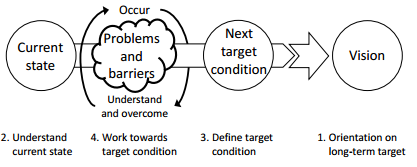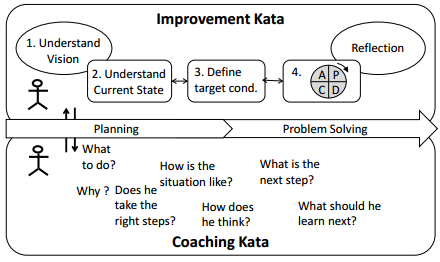The Kaizen – Toyota KATA method
(→Coaching Kata) |
(→Brief history of Kaizen and Toyota Kata) |
||
| Line 7: | Line 7: | ||
==Brief history of Kaizen and Toyota Kata== | ==Brief history of Kaizen and Toyota Kata== | ||
| + | ===Kaizen=== | ||
| + | The word “kaizen” is Japanese for "continuous improvement", where “kai” means change and “zen” good. Even though Kaizen is mostly associated with Japan, its origins are quality improvement methods from the United States, brought to Japan by experts such as W. Edwards Deming after World War II. The quality improvement methods were introduced in Japan under the Training Within Industry program (TWI) [https://en.wikipedia.org/wiki/Training_Within_Industry]. TWI, Inc. was company providing management training founded by Lowell Mellen in Cleveland, Ohio and they provided trainings all around the world but had governmental support in Japan, England and New Zealand (Warren, 2010). The first (out of two) TWI training programs in Japan concerned with Job Instruction, Job Method and Job Relations (“J” programs). To promote the program, prior to its start, TWI developed a training film titled “Four Steps for Improvement” or in Japanese “Kaizen eno Yon Dankai”. The program was delivered in the 1950s. This is when the concept of quality circle groups (group of workers performing the same or similar work meeting regularly to identify, analyse and solve work-related problems) became popular in Japan (Kanbanchi, 2015). | ||
| + | Subsequently, the man who was involved in the introduction of Kaizen to Japan, W. Edwards Deming, was given an award by the Japanese Emperor in 1960 and an annual award for achievements in quality of products was named after him (Deming Prize [https://en.wikipedia.org/wiki/Deming_Prize]). | ||
| + | The term Kaizen actually became famous around the world through the works of Masaaki Imai, in particular, his book “Kaizen: Japanese spirit of improvement” (1985) [https://www.amazon.ca/Kaizen-Key-Japans-Competitive-Success/dp/007554332X/ref=sr_1_2?s=books&ie=UTF8&qid=1367970369&sr=1-2&keywords=kaizen+imai]. He who also founded the Kaizen Institute Consulting Group (KICG) [https://www.kaizen.com/]. | ||
| + | |||
| + | ===Toyota Kata=== | ||
| + | Toyota was one of the companies to very well implement the teachings from TWI and to actually standardize them in the form of the Toyota Production System [https://en.wikipedia.org/wiki/Toyota_Production_System]. The success of Toyota has been so great that western companies have many times tried to follow their ways. This has resulted in the formulation of lean principles and tools. The term “lean” was first mentioned in “The machine that changed the world” [https://www.amazon.com/Machine-That-Changed-World-Revolutionizing-ebook/dp/B001D1SRRS], a book highlighting the gabs between Toyota and other car manufacturers (Teich & Faddoul, 2013). Among the principles are management of value stream, identification of customer value, the pursuit of perfection while reducing all the kinds of waste, the five whys or going after the root cause of a problem. | ||
| + | There is no doubt that Toyota has been successful, nevertheless, according to a survey conducted by Industry Week in 2007 found that 74 percent of companies are not having success with their lean program (Pay, 2008). Mike Rother claims in his book “Toyota Kata” [https://www.amazon.com/Toyota-Kata-Managing-Improvement-Adaptiveness/dp/0071635238] that he has found the reason why Toyota succeeds and the rest have a harder time. [[File:sochin.jpg|200px|thumb|right|Karate Kata]] Here is an example: several years ago, a manager in a western car manufacturer company would go to the Toyota shop floor and see that they are using inventory facades close to the production line, so that the workers can go and fetch what they need easily. Seeing the benefit, the manager would implement it home as well. Two years later, she goes to Toyota again to find out that the facades are now gone and they are using kitting instead. She now has to implement kitting. What this shows is that Toyota seems to be a step ahead with innovation. The solutions, however, are developed to answer specific needs, specific to Toyota, so that when taken and implemented outside, they might not necessarily bring the same results. Mike Rother claims that this problem solving thinking is what companies should be adopting rather than the ready Toyota solutions. This is what he calls Kata, which is a Japanese word which literally means form and is used for the choreographed movements practiced in martial arts (see picture to the right). | ||
| + | In a nutshell, Toyota Kata are the Kaizen practise in Toyota, practiced so often that have become the instinct reaction to a problem, much like when the right karate move is recalled instinctively in a fight situation. Mike Rother figured this out during his research at Toyota when the answer he got on the questions “When do you do Kaizen? When are the Kaizen events held? When do you initiate it a Kaizen activity?” was “What do you mean? It is all the time!”. | ||
==How does it work – processes and tools== | ==How does it work – processes and tools== | ||
Revision as of 14:08, 20 September 2016
Overall there are two paradigms within management – the Command and Control Paradigm (CCP) and the Interaction and Learning Paradigm (ILP) (Rasmussen, 2011). The first one, CCP, would put the manager in the position of an enlightened leader, who has all the answers and operates in a deterministic world. In other words, the manager like the conductor of an orchestra, directs the symphony, giving specific directions to each musician. On the other side, we find the paradigm of interaction and learning, where a manger does not yet have all the answers, but acquires them through interaction. A manager rather than giving detailed action plans, creates a frame for action. It is said that the second approach works better when dealing with complex tasks, varying demands, and unpredictable environments. Within project management these two paradigms are also represented in the form of traditional and agile project management. This article views project management from the ILP paradigm and it assumes that a project or a portfolio manager often needs to deal with problems without having a clear solution. In this situation the right approach always has to do with exploration and innovation.
This article examines a management method, which has proven to be very successful in supporting fast and innovative solutions to complex problems in Toyota, namely Kaizen and the Toyota Kata method. This article states that project and portfolio managers dealing with product or process development and organisational change can benefit from the teachings of Kaizen and Toyota Kata.
The Kaizen method engages manager and employees to think solutions beyond the usual, and ensures continuous improvement, as it breaks the problem at hand into smaller problems, solved one by one using the scientific method (Anon., 2016) of experimentation instead of the usual "implementation" approach. This liberates the solutions as the improvement efforts are allowed to lead to failure and failure is even a welcomed learning. The efforts themselves are encouraged to be small, so that their effect can be controlled and, most importantly, confirmed. An important benefit of the Kaizen management method is the humanisation of the workplace. People working on a Kaizen project feel empowered and full of purpose, as they are not blindly following orders but are part of creating their work environment and procedures. The article starts out by elaborating on the methods origins’ and later describes the processes and tools needed to use it successfully. Benefits and limitations are outlined and finally, the current and future applications of the method within project management are discussed.
Contents |
Brief history of Kaizen and Toyota Kata
Kaizen
The word “kaizen” is Japanese for "continuous improvement", where “kai” means change and “zen” good. Even though Kaizen is mostly associated with Japan, its origins are quality improvement methods from the United States, brought to Japan by experts such as W. Edwards Deming after World War II. The quality improvement methods were introduced in Japan under the Training Within Industry program (TWI) [1]. TWI, Inc. was company providing management training founded by Lowell Mellen in Cleveland, Ohio and they provided trainings all around the world but had governmental support in Japan, England and New Zealand (Warren, 2010). The first (out of two) TWI training programs in Japan concerned with Job Instruction, Job Method and Job Relations (“J” programs). To promote the program, prior to its start, TWI developed a training film titled “Four Steps for Improvement” or in Japanese “Kaizen eno Yon Dankai”. The program was delivered in the 1950s. This is when the concept of quality circle groups (group of workers performing the same or similar work meeting regularly to identify, analyse and solve work-related problems) became popular in Japan (Kanbanchi, 2015). Subsequently, the man who was involved in the introduction of Kaizen to Japan, W. Edwards Deming, was given an award by the Japanese Emperor in 1960 and an annual award for achievements in quality of products was named after him (Deming Prize [2]). The term Kaizen actually became famous around the world through the works of Masaaki Imai, in particular, his book “Kaizen: Japanese spirit of improvement” (1985) [3]. He who also founded the Kaizen Institute Consulting Group (KICG) [4].
Toyota Kata
Toyota was one of the companies to very well implement the teachings from TWI and to actually standardize them in the form of the Toyota Production System [5]. The success of Toyota has been so great that western companies have many times tried to follow their ways. This has resulted in the formulation of lean principles and tools. The term “lean” was first mentioned in “The machine that changed the world” [6], a book highlighting the gabs between Toyota and other car manufacturers (Teich & Faddoul, 2013). Among the principles are management of value stream, identification of customer value, the pursuit of perfection while reducing all the kinds of waste, the five whys or going after the root cause of a problem.
There is no doubt that Toyota has been successful, nevertheless, according to a survey conducted by Industry Week in 2007 found that 74 percent of companies are not having success with their lean program (Pay, 2008). Mike Rother claims in his book “Toyota Kata” [7] that he has found the reason why Toyota succeeds and the rest have a harder time. Here is an example: several years ago, a manager in a western car manufacturer company would go to the Toyota shop floor and see that they are using inventory facades close to the production line, so that the workers can go and fetch what they need easily. Seeing the benefit, the manager would implement it home as well. Two years later, she goes to Toyota again to find out that the facades are now gone and they are using kitting instead. She now has to implement kitting. What this shows is that Toyota seems to be a step ahead with innovation. The solutions, however, are developed to answer specific needs, specific to Toyota, so that when taken and implemented outside, they might not necessarily bring the same results. Mike Rother claims that this problem solving thinking is what companies should be adopting rather than the ready Toyota solutions. This is what he calls Kata, which is a Japanese word which literally means form and is used for the choreographed movements practiced in martial arts (see picture to the right).In a nutshell, Toyota Kata are the Kaizen practise in Toyota, practiced so often that have become the instinct reaction to a problem, much like when the right karate move is recalled instinctively in a fight situation. Mike Rother figured this out during his research at Toyota when the answer he got on the questions “When do you do Kaizen? When are the Kaizen events held? When do you initiate it a Kaizen activity?” was “What do you mean? It is all the time!”.


